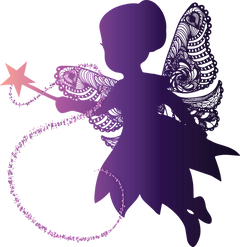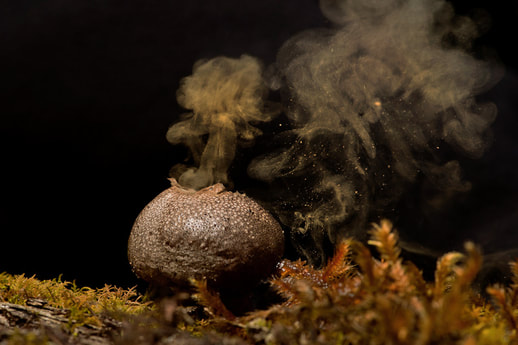|
Fairy dust: maybe it’s the stuff that sparkles from a fairy godmother’s magic wand. Or maybe fairies just naturally exude it. (Or, if you delve into Disney’s expanded Tinker Bell universe, fairies need it to fly and it is a vital resource for which the characters must occasionally go on perilous quests.) Alternately, in craft stores I’ve come across little bottles of glitter labeled “fairy dust” to be used in a fairy garden. But where did the idea of fairy dust come from? I went looking for older sources which mentioned fairies in connection with dust. Some are fairly mundane. The fairies in A Midsummer Night’s Dream, like helpful household brownies, “sweep the dust behind the door.” Okay, so that’s not really their dust. In reverse, according to Thomas Keightley, the German kobold “brings chips and saw-dust into the house, and throws dirt into the milk vessels.” Closer is John Rhys' Celtic Folklore: Welsh and Manx, where he tells of a fisherman named William Ellis who - out on a dark misty day - saw a large crowd of little people about a foot tall, all dancing and making music. Entranced, he watched for hours, but when he approached too close, "they threw a kind of dust into his eyes, and, while he was wiping it away, the little family took the opportunity of betaking themselves somewhere out of his sight, so that he neither saw nor heard anything more of them." Similar, though it doesn't feature dust per se, is the tale of Yallery Brown. There, the titular elf blows a dandelion puff into a boy's eyes and ears. "Soon as Tom could see again the tiddy [tiny] creature was gone." George Sand's short story "La fee poussiere" was translated as "The Fairy Dust" in 1891. "Fairy Dust" in this case is the name of a character, a fairylike being who oversees everything from the earth itself to tiny particles of dust. The main character encounters her in a dream. In Félicité de Choiseul-Meuse's 1820 fairytale "The Marble Princess," a fairy godmother gives a prince "gold dust of the purest quality" to blind serpents so that he can fight them. "What Mr. Maguire Saw in the Kitchen," an 1862 story, a character waking from a disorienting dream refers to "dust . . . fairy dust that took away my five senses to the other world, and put me beyond myself." (Dialect removed.) Mary Augusta Ward's Milly and Olly: or, A Holiday Among the Mountains (1881) features a mention of a fairy throwing golden "fairy-dust" into a girl's eyes so that she sees the beauty in a certain place. There are no literal fairies in the book, but the description is significant. So far, two tales feature dreams, two have dust used to physically blind others, and the last has dust which alters someone's perception of the world. Why this connection between fairies and dust in the first place? An interesting link might lie with mushrooms. Many varieties are named for the fairies, and they have traditionally been associated with fairies in a number of ways, possibly in part because of some toadstools' hallucinogenic properties. One particular fungi tied to fairies is the puffball, a mushroom full of brown dust-like spores that are released when it bursts. Other names include "puckball," “puckfist,” “pixie-puff” or “devil’s snuffbox." (In this case, "fist" does not mean a closed hand, but a fart or foul odor. So these mushrooms were the Devil’s/Puck’s/Fairy’s farts.) In Scotland they were known as Blind Man’s Ball or Blind Man’s Een (eyes). John Jamieson suggested in 1808 that this was due to a belief that the spores caused blindness. However, it’s also possible that they were named for their resemblance to eyeballs. The mushroom connection is fun, but European puffball mushrooms are evidently not hallucinogenic. Another possible plant association: pollen, which can look like golden (yellow) dust, and which would have become a stronger link as the modern flower fairy gained popularity. The Victorian educational children's book, Fairy Know-a-Bit, or, A Nutshell of Knowledge (1866) declares that fairies refer to pollen as "gold-dust" and love "to sprinkle [it] over each other in sport."
There is another very old tie between fairies and dust. Traditionally, fairies were believed to be present in the dust clouds stirred up by the wind on the road. Any humans on the road should beware, and show respect to the otherworldly travelers. The cloud of dust might even contain kidnapped humans who were carried along with the fairies. It's been suggested that the Rumpelstiltskin-like character Whuppity Stoorie has a name meaning whipped-up dust, or stoor. For a similar concept, think of the term "dust devil" for a whirlwind. This idea may be tracked back to the 17th century at least. In 1662, accused witch Isobel Gowdie pulled from fairy lore for her confession. She described how witches, like fairies, would use tiny grass stalks as horses to "fly away, where we would, even as straws fly upon a highway" – in a whirlwind of bits of straw above the road. She added that "If anyone sees these straws in a whirlwind, and do not bless themselves, we may shoot them dead at our pleasure. Any that are shot by us... will fly as our horses, as small as straws." There's also a touch of the idea of perception here. Humans perceive only a cloud of dust, but those "in the know" realize that fairies are traveling unseen. In Teutonic Mythology vol. 3, Jacob Grimm makes a reference to witches' or devil's ashes being strewn to raise storms, and Richilde (enemy of Robert the Frisian) throwing dust in the air with "formulas of imprecation" to destroy her enemies. One more traditional connection between fairies and dust is quite sinister. In many stories, when a human returns from Fairyland, they do so without realizing that they’ve unwittingly spent centuries away from our world. King Herla, for instance, gets a nasty shock when some of his friends dismount from their horses only to crumble into dust the second their feet touch the ground. However, the key to modern fairy dust is the story of the Sandman. In European folklore, every night a mythical being sprinkles sand or dust into children’s eyes to send them to sleep and give them dreams. The sand/dust may be a way to explain the “sleep” or gritty discharge left in someone’s eyes when they wake up in the morning. E. T. A. Hoffmann’s 1816 short story Der Sandmann features a sinister Sandman who steals children’s eyes after throwing sand at them. Hans Christian Andersen’s 1841 tale "Ole Lukøje" ("Mr. Shut-eye") has a gentle sleep-bringer who sprinkles “sweet milk” into children’s eyes. However, subsequent translations changed this to “powder” or “dust" as the character was gradually merged with the Sandman. There was overlap with the fairy world, and this would only increase. A 1915 dictionary defined the Sandman as "a household elf.” The children's play “Bluebell in Fairyland,” first produced in 1901, was one of the inspirations for Peter Pan. The main character's travel to Fairyland is framed as a dream. Per John Kruse's site British Fairies, the play mentions the "dustman" (Sandman) and features golden dust being strewn as the characters fall asleep and enter Fairyland. Unfortunately, the play's script and lyrics are not currently available where I can access them. Algernon Blackwood's 1913 book A Prisoner of Fairyland may also have been influenced by Bluebell. It features a “Dustman” who sprinkles golden dust “fine as star-dust” into people’s eyes to cause them to sleep. Again: sleep, dreams and fairyland are interconnected. But it was J. M. Barrie’s Peter Pan (play published 1904, novel published 1911) which really popularized the modern view of fairy dust. From the moment Peter Pan first physically appears in the novel, he is accompanied by fairy dust: “the window was blown open by the breathing of the little stars, and Peter dropped in. He had carried Tinker Bell part of the way, and his hand was still messy with the fairy dust.” The dust which Tinker Bell exudes bestows children with the ability to fly, and to travel to Neverland, which is made up of their own imaginative stories and daydreams. The island is first described in a sequence where the Darlings' mother examines her sleeping children's minds. When the children reach the island, they find all the locations and characters they've dreamed up. At one point Peter Pan speaks to "all who might be dreaming of the Neverland, and who were therefore nearer to him than you think." Disney’s animated adaptation came out in 1953. They altered it a little, calling the stuff “pixie dust.” Tinker Bell became an instant mascot, and her pixie dust was a callword for Disney. (They use "pixie" and "fairy" interchangeably to refer to the character, which is a post for another time.) Neverland's status as both fairyland and dreamworld is toned down in the film version, but still hinted at. The Darling children meet Peter Pan when he wakes them in the middle of the night, and - unlike the book - after they return, their parents enter the room only to find them fast asleep, as if they never left. Disney's ubiquitous Peter Pan helped popularize the modern idea of fairy dust as glittering stuff given off by fairies or pixies. It was also an important step in leaving behind the associations with dreams and, thus, the Sandman. Associations between fairies and dust are very old, seen in the whirlwind transportation and in puffball mushrooms. By the 1800s, we have mentions in literature tying fairy dust to vision, eyesight, dreams, and perception of reality. Ultimately fairies and the Sandman were equated, as were Fairyland and Dreamland. At this point, they've diverged. However, I am reminded of the 2012 animated film Rise of the Guardians, where the Sandman works with glowing golden sand that looks a lot like Disney Tinker Bell's pixie dust. Also, "fairy dust" and similarly "angel dust" are slang terms for drugs, keeping that idea of a change in perception. References and Further Reading
Text copyright © Writing in Margins, All Rights Reserved
0 Comments
Leave a Reply. |
About
Researching folktales and fairies, with a focus on common tale types. Archives
July 2024
Categories
All
|
Writing in Margins


 RSS Feed
RSS Feed
